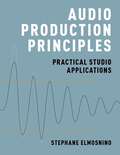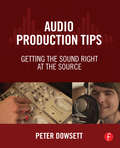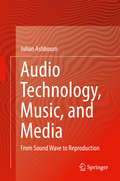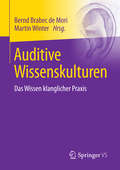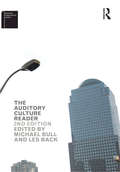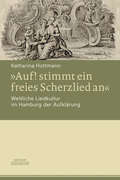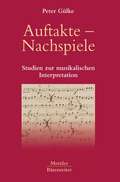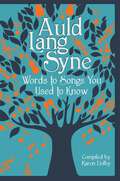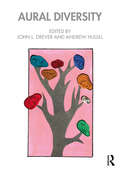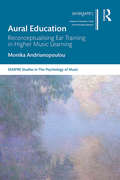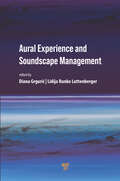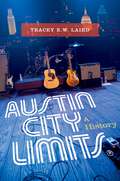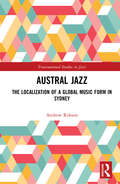- Table View
- List View
AUDIO PRODUCTION PRINCIPLES C: Practical Studio Applications
by Stephane ElmosninoWith this all-in-one manual, students and teachers have an easy-to-read reference that provides a reliable and current rundown of the world of sound production, from planning a recording session to mastering the final product. Organized by four main topics - pre-production, recording various instruments, mixing theories and tools, and mastering - Audio Production Principles follows the actual flow of instruction given over the course of a student's tenure. Chapters address etiquette and basic operations for any recording session written in useful, tutorial style language, providing guidelines for beginner audio engineers on topics including pre-production, equipment selection, and mixing tips by instrument. Jumpstarting the mastering process, lessons delve into features unique to specific tools and techniques. All sections offer instructional scenarios of studio setups, asking students to brainstorm the best production technique for each situation. These exercises also help teachers generate new ideas for instruction and production projects of their own.
Audio Production Tips: Getting the Sound Right at the Source
by Peter DowsettAudio Production Tips: Getting the Sound Right at the Source provides practical and accessible information detailing the production processes for recording today’s bands. By demonstrating how to "get the sound right at the source," author Peter Dowsett lays the appropriate framework to discuss the technical requirements of optimizing the sound of a source. Through its coverage of critical listening, pre-production, arrangement, drum tuning, gain staging and many other areas of music production, Audio Production Tips allows you to build the wide array of skills that apply to the creative process of music production. Broken into two parts, the book first presents foundational concepts followed by more specific production advice on a range of instruments. Key features: Important in-depth coverage of music theory, arrangement and its applications. Real life examples with key references to the author’s music production background. Presents concepts alongside the production of a track captured specifically for the book. A detailed companion website, including audio, video, Pro Tools session files of the track recording process, and videos including accompanying audio that can be examined in the reader’s DAW. Please visit the accompanying companion website, available at www.audioproductiontips.com, for resources that further support the book’s practical approach.
Audio Production Tips: Getting the Sound Right at the Source
by Peter DowsettAudio Production Tips: Getting the Sound Right at the Source provides practical and accessible information detailing the production processes for recording today’s bands. By demonstrating how to "get the sound right at the source," author Peter Dowsett lays the appropriate framework to discuss the technical requirements of optimizing the sound of a source. Through its coverage of critical listening, pre-production, arrangement, drum tuning, gain staging and many other areas of music production, Audio Production Tips allows you to build the wide array of skills that apply to the creative process of music production. Broken into two parts, the book first presents foundational concepts followed by more specific production advice on a range of instruments. Key features: Important in-depth coverage of music theory, arrangement and its applications. Real life examples with key references to the author’s music production background. Presents concepts alongside the production of a track captured specifically for the book. A detailed companion website, including audio, video, Pro Tools session files of the track recording process, and videos including accompanying audio that can be examined in the reader’s DAW. Please visit the accompanying companion website, available at www.audioproductiontips.com, for resources that further support the book’s practical approach.
Audio Technology, Music, and Media: From Sound Wave to Reproduction
by Julian AshbournThis book provides a true A to Z of recorded sound, from its inception to the present day, outlining how technologies, techniques, and social attitudes have changed things, noting what is good and what is less good. The author starts by discussing the physics of sound generation and propagation. He then moves on to outline the history of recorded sound and early techniques and technologies, such as the rise of multi-channel tape recorders and their impact on recorded sound. He goes on to debate live sound versus recorded sound and why there is a difference, particularly with classical music. Other topics covered are the sound of real instruments and how that sound is produced and how to record it; microphone techniques and true stereo sound; digital workstations, sampling, and digital media; and music reproduction in the home and how it has changed. The author wraps up the book by discussing where we should be headed for both popular and classical music recording and reproduction, the role of the Audio Engineer in the 21st century, and a brief look at technology today and where it is headed. This book is ideal for anyone interested in recorded sound. “[Julian Ashbourn] strives for perfection and reaches it through his recordings… His deep knowledge of both technology and music is extensive and it is with great pleasure that I see he is passing this on for the benefit of others. I have no doubt that this book will be highly valued by many in the music industry, as it will be by me.” -- Claudio Di Meo, Composer, Pianist and Principal Conductor of The Kensington Philharmonic Orchestra, The Hemel Symphony Orchestra and The Lumina Choir
Auditive Wissenskulturen: Das Wissen klanglicher Praxis
by Bernd Brabec de Mori Martin WinterDie sozial- und kulturwissenschaftliche Erforschung auditiver Phänomene ist stets mit spezifischen Wissensformen konfrontiert. Die Rolle, die Musik und andere Klänge in verschiedenen sozialen und kulturellen Kontexten spielen, hängt mit dem Wissen zusammen, welches in bestimmter Weise (re)produziert und vermittelt wird. Wir können etwas über Klänge wissen, oder etwas durch Klänge wissen. Wir können Wissen über die spezifische Erzeugung von Klängen erwerben und weitergeben, oder aber Nachrichten – etwa eine Warnung – klanglich übermitteln. Diese vielfältigen Formen von Klangwissen können auf sehr unterschiedliche Weisen zum Gegenstand wissenschaftlicher Untersuchungen gemacht werden. Der vorliegende Band zu auditiven Wissenskulturen ist ein Versuch, jene üblicherweise in verschiedenen Disziplinen wie Soziologie und Anthropologie, in Geschichte, Psychologie, Ethnologie und Philosophie der Musik oder in Medienwissenschaften verorteten Zugänge zu auditivem Wissen in ein produktives interdisziplinäres Gespräch zu bringen.
The Auditory Culture Reader (Sensory Formations)
by Michael BullThe first edition of The Auditory Culture Reader offered an introduction to both classical and recent work on auditory culture, laying the foundations for new academic research in sound studies. Today, interest and research on sound thrives across disciplines such as music, anthropology, geography, sociology and cultural studies as well as within the new interdisciplinary sphere of sound studies itself. This second edition reflects on the changes to the field since the first edition and offers a vast amount of new content, a user-friendly organization which highlights key themes and concepts, and a methodologies section which addresses practical questions for students setting out on auditory explorations. All essays are accessible to non-experts and encompass scholarship from leading figures in the field, discussing issues relating to sound and listening from the broadest set of interdisciplinary perspectives. Inspiring students and researchers attentive to sound in their work, newly-commissioned and classical excerpts bring urban research and ethnography alive with sensory case studies that open up a world beyond the visual. This book is core reading for all courses that cover the role of sound in culture, within sound studies, anthropology, sociology, cultural studies, history, media studies and urban geography.
The Auditory Culture Reader (Sensory Formations)
by Michael Bull Les BackThe first edition of The Auditory Culture Reader offered an introduction to both classical and recent work on auditory culture, laying the foundations for new academic research in sound studies. Today, interest and research on sound thrives across disciplines such as music, anthropology, geography, sociology and cultural studies as well as within the new interdisciplinary sphere of sound studies itself. This second edition reflects on the changes to the field since the first edition and offers a vast amount of new content, a user-friendly organization which highlights key themes and concepts, and a methodologies section which addresses practical questions for students setting out on auditory explorations. All essays are accessible to non-experts and encompass scholarship from leading figures in the field, discussing issues relating to sound and listening from the broadest set of interdisciplinary perspectives. Inspiring students and researchers attentive to sound in their work, newly-commissioned and classical excerpts bring urban research and ethnography alive with sensory case studies that open up a world beyond the visual. This book is core reading for all courses that cover the role of sound in culture, within sound studies, anthropology, sociology, cultural studies, history, media studies and urban geography.
Auf den Straßen des Südens: Musiker, Räume und Performance in mexikanischen Überlandbussen (Studien zur Popularmusik)
by Sven KirschlagerDie Überlandbusse Südmexikos dienen nicht allein als Transportmittel. Täglich verwandeln unzählige lokale Akteur_innen die Fahrzeuge in mobile Räume informellen Handels. Sie werden von Verkäufer_innen und Prediger_innen genutzt, aber auch von Musiker_innen, die sie in der Hoffnung auf Spenden zu ihrer Bühne machen. Sven Kirschlager nimmt die Musiker_innen in den Fokus und beleuchtet ihre kreativen Strategien, wenn sie sich die Busse als Räume ihrer Performances aneignen und mobile Passagier_innen mit lokalen Zwischenräumen verbinden. Dabei bricht er mit romantisierenden Vorstellungen und zeigt den täglichen Überlebenskampf der Musiker_innen in einem Netzwerk räumlicher Hierarchien.
»Auf! stimmt ein freies Scherzlied an«. Weltliche Liedkultur im Hamburg der Aufklärung
by Katharina HottmannAus kulturgeschichtlicher Perspektive beschreibt die Studie die Einbindung der (Lied-)Musik in den übergreifenden Prozess der Aufklärung, leuchtet ihre Wechselwirkung mit anderen Künsten aus und lässt die komplexe Einbindung musikkultureller Praxis in gesellschaftliche Strukturen sichtbar werden. - Im 18. Jahrhundert entfaltete sich in Hamburg eine der lebendigsten weltlichen Liedkulturen der Epoche, die ihren sozialen Platz in städtischen Geselligkeitskontexten fand. Die zwar schlichten, dennoch aber pointierenden Kompositionen vertieften die Botschaften der Liedlyrik mit ihren zentralen Themen Liebe, Wein und satirische Kritik. Im Selbstverständnis der Aufklärung dienten Lieder gleichermaßen zur Konstituierung von Geselligkeit wie zur Vermittlung von Lebenserfahrung und körperlich-seelischer Selbstregulation.
Aufführungsrituale der Musik: Zur Konstituierung kultureller Vielfalt am Beispiel Österreich (texte zur populären musik #11)
by Magdalena Fürnkranz Harald HuberDie Unterscheidung von E-Musik und U-Musik hat ausgedient. Als neuen Ansatz präsentieren Magdalena Fürnkranz und Harald Huber ein Stilfeldermodell und führen es am Beispiel der österreichischen Musiklandschaft der Gegenwart aus. In Form von qualitativen Fallstudien und vergleichenden Analysen erkunden sie Differenzen und Diffusionen zwischen den Stilfeldern »Klassik/zeitgenössische Musik«, »Jazz/improvisierte Musik«, »Volksmusik/World Music«, »Dance/HipHop/Elektronik«, »Rock- und Popmusik« sowie »Schlager/volkstümliche Musik«. Der kultursoziologische Ansatz von Pierre Bourdieu erfährt hier eine transformierte Konkretisierung und dient der Neubestimmung musikalisch-kultureller Diversität und Hybridität.
Auftakte – Nachspiele: Studien zur musikalischen Interpretation
by Peter GülkeMusik zwischen Inspiration und Reflexion. Gülkes Schriften geben Auskunft u.a. zu historischer Aufführungspraxis, zur Entwicklung des Orchesters, zur Musikedition, zur musikalischer Interpretation einzelner Werke und zum Wandel des Dirigentenbildes. Porträtiert werden zudem große Dirigenten, darunter Bülow, Mahler, Toscanini, Furtwängler, Wand, Kleiber und von Karajan. Gülke verbindet den persönlichen Blick mit fundiertem Wissen.
Auld Lang Syne: Words to Songs You Used to Know
by Karen DolbyAuld Lang Syne is a timeless collection of lyrics for all to cherish.Our memories are bursting with half-remembered songs. They stick with us in a way that no other words do. Just the first few notes of a tune can bring a sports stadium full of people to their feet or kindle memories of starlit nights around a campfire, or a bedtime lullaby soothing us to sleep. But so often after those first few lines we’re left humming until the chorus comes back in. With this book you need never miss a line again. Inside you’ll find:* Beloved songs from across the English-speaking world, including tunes from Australia, America, Canada, Ireland as well as the UK* Lesser-known gems among the firm favourites* Short accompanying text explaining the origins and stories behind the lyrics celebrating the wonderful variety of songs, shanties, ballads, ditties and anthems that wind through our lives and bring us together.
Auld Lang Syne: A Song and its Culture
by Morag Josephine GrantIn Auld Lang Syne: A Song and its Culture, M. J. Grant explores the history of this iconic song, demonstrating how its association with ideas of fellowship, friendship and sociality has enabled it to become so significant for such a wide range of individuals and communities around the world. This engaging study traces different stages in the journey of Auld Lang Syne, from the precursors to the song made famous by Robert Burns to the traditions and rituals that emerged around the song in the nineteenth and early twentieth centuries, including its use as a song of parting, and as a song of New Year. Grant’s painstaking study investigates the origins of these varied traditions, and their impact on the transmission of the song right up to the present day. Grant uses Auld Lang Syne to explore the importance of songs and singing for group identity, arguing that it is the active practice of singing the song in group contexts that has made it so significant for so many. The book offers fascinating insights into the ways that Auld Lang Syne has been received, reused and remixed around the world, concluding with a chapter on more recent versions of the song back in Scotland. This highly original and accessible work will be of great interest to non-expert readers as well as scholars and students of musicology, cultural and social history, social anthropology and Scottish studies. The book contains a wealth of illustrations and includes links to many more, including manuscript sources. Audio examples are included for many of the musical examples. Grant’s extensive bibliography will moreover ease future referencing of the many sources consulted.
Aural Book 1 Specimen Aural Tests: Initial–Grade 5, for Trinity College London exams from 2017 (PDF)
by Trinity College London PressThis title has an accompanying mp3 audio files available from RNIB Bookshare. Please request these by contacting us at bookshare@rnib.org.uk quoting the title and ISBN number and requesting the mp3 files. We’ll then send them to you. Aural Book 1 Specimen Aural Tests: Initial–Grade 5, for Trinity College London exams from 2017
Aural Book 1 Specimen Aural Tests: Initial–Grade 5, for Trinity College London exams from 2017 (PDF)
by Trinity College London PressThis title has an accompanying mp3 audio files available from RNIB Bookshare. Please request these by contacting us at bookshare@rnib.org.uk quoting the title and ISBN number and requesting the mp3 files. We’ll then send them to you.
Aural Book 2 Specimen Aural Tests: Grades 6-8, for Trinity College London exams from 2017 (PDF)
by Trinity College London PressThis title has an accompanying mp3 audio files available from RNIB Bookshare. Please request these by contacting us at bookshare@rnib.org.uk quoting the title and ISBN number and requesting the mp3 files. We’ll then send them to you. Aural Book 2 Specimen Aural Tests: Grades 6-8, for Trinity College London exams from 2017
Aural Diversity
by John L. Drever Andrew HugillAural Diversity addresses a fundamental methodological challenge in music and soundscape research by considering the nature of hearing as a spectrum of diverse experiences. Bringing together an interdisciplinary array of contributors from the arts, humanities, and sciences, it challenges the idea of a normative listening experience and envisions how awareness of aural diversity can transform sonic arts, environments, and design and generate new creative listening practices. With contributors from a wide range of fields including sound studies, music, hearing sciences, disability studies, acoustics, media studies, and psychology, Aural Diversity introduces a new and much-needed paradigm that is relevant to scholars, students, and practitioners engaging with sound, music, and hearing across disciplines.
Aural Diversity
by John L. Drever Andrew HugillAural Diversity addresses a fundamental methodological challenge in music and soundscape research by considering the nature of hearing as a spectrum of diverse experiences. Bringing together an interdisciplinary array of contributors from the arts, humanities, and sciences, it challenges the idea of a normative listening experience and envisions how awareness of aural diversity can transform sonic arts, environments, and design and generate new creative listening practices. With contributors from a wide range of fields including sound studies, music, hearing sciences, disability studies, acoustics, media studies, and psychology, Aural Diversity introduces a new and much-needed paradigm that is relevant to scholars, students, and practitioners engaging with sound, music, and hearing across disciplines.
Aural Education: Reconceptualising Ear Training in Higher Music Learning (SEMPRE Studies in The Psychology of Music)
by Monika AndrianopoulouAural Education: Reconceptualising Ear Training in Higher Music Learning explores the practice of musical ‘aural training’ from historical, pedagogical, psychological, musicological, and cultural perspectives, and uses these to draw implications for its pedagogy, particularly within the context of higher music education. The multi-perspective approach adopted by the author affords a broader and deeper understanding of this branch of music education, and of how humans relate to music more generally. The book extracts and examines one by one different parameters that appear central to ‘aural training’, proceeding in a gradual and well-organised way, while at the same time constantly highlighting the multiple interconnections and organic unity of the many different operations that take place when we interact with music through any music-related activity. The resulting complex profile of the nature of our relationship with music, combined with an exploration of non-Western cultural perspectives, offer fresh insights on issues relating to musical ‘aural training’. Emerging implications are proposed in the form of broad pedagogical principles, applicable in a variety of different music educational settings. Andrianopoulou propounds a holistic alternative to ‘aural training’, which acknowledges the richness of our relationship to music and is rooted in absorbed aural experience. The book is a key contribution to the existing literature on aural education, designed with researchers and educators in mind.
Aural Education: Reconceptualising Ear Training in Higher Music Learning (SEMPRE Studies in The Psychology of Music)
by Monika AndrianopoulouAural Education: Reconceptualising Ear Training in Higher Music Learning explores the practice of musical ‘aural training’ from historical, pedagogical, psychological, musicological, and cultural perspectives, and uses these to draw implications for its pedagogy, particularly within the context of higher music education. The multi-perspective approach adopted by the author affords a broader and deeper understanding of this branch of music education, and of how humans relate to music more generally. The book extracts and examines one by one different parameters that appear central to ‘aural training’, proceeding in a gradual and well-organised way, while at the same time constantly highlighting the multiple interconnections and organic unity of the many different operations that take place when we interact with music through any music-related activity. The resulting complex profile of the nature of our relationship with music, combined with an exploration of non-Western cultural perspectives, offer fresh insights on issues relating to musical ‘aural training’. Emerging implications are proposed in the form of broad pedagogical principles, applicable in a variety of different music educational settings. Andrianopoulou propounds a holistic alternative to ‘aural training’, which acknowledges the richness of our relationship to music and is rooted in absorbed aural experience. The book is a key contribution to the existing literature on aural education, designed with researchers and educators in mind.
Aural Experience and Soundscape Management
by Diana Grguri Lidija Runko LuttenbergerSince technological progress is characterized by the dual effects, positive and negative, it is precisely by sustaining the balance between such binaries that ecologically responsible resource management is restored as a solution for excessive human impact on the environment. Sound and music became relevant from the perspective of management, within the meaning of controlling their negative effects on human beings and their environment as well as utilizing them for meeting human needs. This book integrates the fields of technology, humanities, and social sciences and defines the challenges of noise control from the perspective of acoustic ecology. It discusses the concept of acoustic ecology applied to evoke sound and music management and design solutions for well-being. It will be equally useful for students of electrical engineering, music, and economics; equally challenging to those with a particular prior knowledge and practice; and as much as comprehensive and stimulative for those who are barely embarking upon a new adventure.
Aural Experience and Soundscape Management
Since technological progress is characterized by the dual effects, positive and negative, it is precisely by sustaining the balance between such binaries that ecologically responsible resource management is restored as a solution for excessive human impact on the environment. Sound and music became relevant from the perspective of management, within the meaning of controlling their negative effects on human beings and their environment as well as utilizing them for meeting human needs. This book integrates the fields of technology, humanities, and social sciences and defines the challenges of noise control from the perspective of acoustic ecology. It discusses the concept of acoustic ecology applied to evoke sound and music management and design solutions for well-being. It will be equally useful for students of electrical engineering, music, and economics; equally challenging to those with a particular prior knowledge and practice; and as much as comprehensive and stimulative for those who are barely embarking upon a new adventure.
Austin City Limits: A History
by Tracey E. LairdAustin City Limits is the longest running musical showcase in the history of television, and it still captivates audiences forty years after its debut on the air. From Willie Nelson's legendary pilot show and his fourteen magical episodes running through the years to Season 35, to mythical performances of BB King and Stevie Ray Vaughn, to repeat appearances from Chet Atkins, Bonnie Raitt and Ray Charles, and recent shows with Mumford & Sons, Arcade Fire and The Decemberists, the show has defined popular roots music and indie rock. This is why country rocker Miranda Lambert -- relatively unknown when she taped a show almost a decade ago -- gushed to the studio audience, "Now I know I have arrived!" Austin City Limits: A History tells this remarkable story. With unprecedented access behind the scenes at the tapings of shows with Gillian Welch and David Rawlings, Mos Def, Wilco, and many more, author Tracey Laird tells the story of this landmark musical showcase whose history spans dramatic changes in the world of television, the expansion of digital media, and the ways in which we experience music. Beginning as a simple weekly broadcast, it is today a multifaceted "brand" in contemporary popular music, existing simultaneously as a program available for streaming, a presence on Twitter and other social media, a major music festival, and a state-of-the-art performance venue. Laird explores the ways in which the show's evolution has driven, and been driven by, both that of Austin as the "Live Music Capital of the World," and of U.S. public media as a major player in the dissemination and sponsorship of music and culture. Engagingly written and packed with anecdotes and insights from everyone from the show's producers and production staff to the musicians themselves, Austin City Limits: A History gives us the best seat in the house for this illuminating look at a singular presence in American popular music. Timed to publish with the airing of Austin City Limits 2014 -- the 40th anniversary celebratory broadcast featuring an all-star lineup of musicians including the Foo Fighters, Willie Nelson, Sheryl Crow, and others -- here is a book for all fans of this beloved music institution.
Austin City Limits: A History
by Tracey E. LairdAustin City Limits is the longest running musical showcase in the history of television, and it still captivates audiences forty years after its debut on the air. From Willie Nelson's legendary pilot show and his fourteen magical episodes running through the years to Season 35, to mythical performances of BB King and Stevie Ray Vaughn, to repeat appearances from Chet Atkins, Bonnie Raitt and Ray Charles, and recent shows with Mumford & Sons, Arcade Fire and The Decemberists, the show has defined popular roots music and indie rock. This is why country rocker Miranda Lambert -- relatively unknown when she taped a show almost a decade ago -- gushed to the studio audience, "Now I know I have arrived!" Austin City Limits: A History tells this remarkable story. With unprecedented access behind the scenes at the tapings of shows with Gillian Welch and David Rawlings, Mos Def, Wilco, and many more, author Tracey Laird tells the story of this landmark musical showcase whose history spans dramatic changes in the world of television, the expansion of digital media, and the ways in which we experience music. Beginning as a simple weekly broadcast, it is today a multifaceted "brand" in contemporary popular music, existing simultaneously as a program available for streaming, a presence on Twitter and other social media, a major music festival, and a state-of-the-art performance venue. Laird explores the ways in which the show's evolution has driven, and been driven by, both that of Austin as the "Live Music Capital of the World," and of U.S. public media as a major player in the dissemination and sponsorship of music and culture. Engagingly written and packed with anecdotes and insights from everyone from the show's producers and production staff to the musicians themselves, Austin City Limits: A History gives us the best seat in the house for this illuminating look at a singular presence in American popular music. Timed to publish with the airing of Austin City Limits 2014 -- the 40th anniversary celebratory broadcast featuring an all-star lineup of musicians including the Foo Fighters, Willie Nelson, Sheryl Crow, and others -- here is a book for all fans of this beloved music institution.
Austral Jazz: The Localization of a Global Music Form in Sydney
by Andrew RobsonAustral Jazz: The Localization of a Global Music Form in Sydney proposes a new theoretical framework for understanding local jazz communities as they develop outside the United States, demonstrating such processes in action by applying the framework to a significant period of the history of jazz in Sydney, Australia after 1973. This volume introduces the notion of ‘Austral Jazz,’ coined in order to reset the focus on supranational conceptions of jazz expressions in the southwestern Pacific. It makes the case for Austral Jazz chronologically across six chapters that discuss, interpret and critique major events and seminal recordings, tracing the development of the Austral shift from a pre-Austral period prior to 1973. Austral Jazz presents a fresh approach to understanding the development of jazz communities, and while its focus is on the Sydney scene after 1973, the ‘Austral’ theory can be applied to creative communities globally. A creative shift took place in Sydney in the early 1970s, which led to the flourishing of a new kind of jazz-based expression, one that reflected Australia’s increasingly globalized and multicultural outlook. This study is timely, and it builds on the work of local jazz researchers. Historiographical understandings of global developments in jazz can be understood within a framework of four overarching narratives: The ‘birth and belonging’ narrative; the ‘spread and adaptation’ narrative; the ‘pluralization by localization’ narrative; and the ‘self-fashioning of the already local’ narrative.
